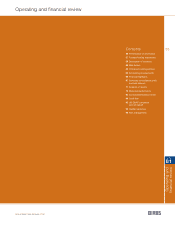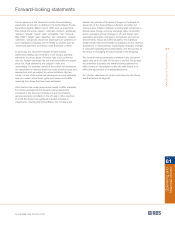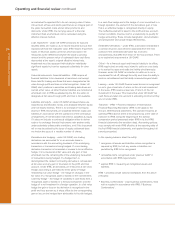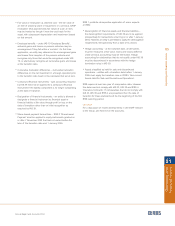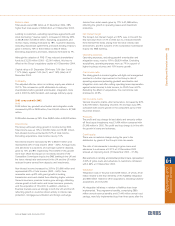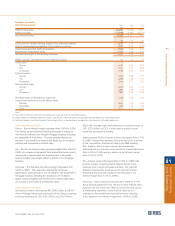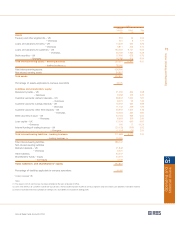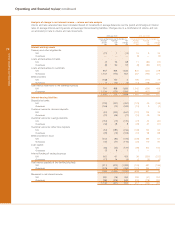RBS 2004 Annual Report Download - page 66
Download and view the complete annual report
Please find page 66 of the 2004 RBS annual report below. You can navigate through the pages in the report by either clicking on the pages listed below, or by using the keyword search tool below to find specific information within the annual report.
64
Operating and financial review
Operating and financial review continued
an instrument’s expected life to its net carrying value. It takes
into account all fees and points paid that are an integral part of
the yield, transaction costs and all other premiums and
discounts. Under IFRS, the carrying value of a financial
instrument held at amortised cost is calculated using the
effective interest method.
Loan impairment – under UK GAAP, provisions for bad and
doubtful debts are made so as to record impaired loans at their
expected ultimate net realisable value. IFRS require impairment
losses on financial assets carried at amortised cost to be
measured as the difference between the asset’s carrying
amount and the present value of estimated future cash flows
discounted at the asset’s original effective interest rate.
Impairment must be assessed individually for individually
significant assets but can be assessed collectively for other
assets.
Financial instruments: financial liabilities – IFRS require all
financial liabilities to be measured at amortised cost except
those held for trading and those that were designated as fair
value through profit and loss on initial recognition. Under UK
GAAP, short positions in securities and trading derivatives are
carried at fair value, all other financial liabilities are recorded at
amortised cost. In IFRS as adopted by the EU, the option to
designate at fair value through profit and loss is not available.
Liabilities and equity – under UK GAAP, all issued shares are
classified as shareholders’ funds, and analysed between equity
and non-equity interests. There is no concept of non-equity
shares in IFRS. Instruments are classified between equity and
liabilities in accordance with the substance of the contractual
arrangements. A non-derivative instrument is classified as equity
if it does not include a contractual obligation either to deliver
cash or to exchange financial instruments with another entity
under potentially unfavourable conditions, and if the instrument
will or may be settled by the issue of equity, settlement does
not involve the issue of a variable number of shares.
Derivatives and hedging – under UK GAAP, non-trading
derivatives are accounted for on an accruals basis in
accordance with the accounting treatment of the underlying
transaction or transactions being hedged. If a non-trading
derivative transaction is terminated or ceases to be an effective
hedge, it is re-measured at fair value and any gain or loss
amortised over the remaining life of the underlying transaction
or transactions being hedged. If a hedged item is
derecognised the related non-trading derivative is remeasured
at fair value and any gain or loss taken to the profit and loss
account. Under IFRS, all derivatives are measured at fair value.
Hedge accounting is permitted for three types of hedge
relationship: fair value hedge – the hedge of changes in the
fair value of a recognised asset or liability or firm commitment;
cash flow hedge – the hedge of variability in cash flows from a
recognised asset or liability or a forecast transaction; and the
hedge of a net investment in a foreign operation. In a fair value
hedge the gain or loss on the derivative is recognised in the
profit and loss account as it arises offset by the corresponding
gain or loss on the hedged item attributable to the risk hedged.
In a cash flow hedge and in the hedge of a net investment in a
foreign operation, the element of the derivative’s gain or loss
that is an effective hedge is recognised directly in equity.
The ineffective element is taken to the profit and loss account.
Certain conditions must be met for a relationship to qualify for
hedge accounting. These include designation, documentation
and prospective and actual hedge effectiveness.
Embedded derivatives – under IFRS, a derivative embedded in
a contract must be accounted for separately from the host
contract if the embedded derivative has economic
characteristics that differ from those of the host contract. There
is no equivalent requirement in UK GAAP.
Offset – for a financial asset and financial liability to be offset,
IFRS require that an entity must intend to settle on a net basis
or to realise the asset and settle the liability simultaneously.
However, under UK GAAP an intention to settle net is not a
requirement for set off, although the entity must have the ability to
insist on net settlement and that ability is assured beyond doubt.
Leasing – under UK GAAP, finance lease income is recognised
so as to give a level rate of return on the net cash investment
in the lease. IFRS require a level rate of return on the net
investment in the lease. This means that under UK GAAP tax
cash flows are taken into account in allocating income but they
are not under IFRS.
Transition – IFRS 1 ‘First-time Adoption of International
Financial Reporting Standards’ (IFRS 1) will apply to the
Group's 2005 financial statements. The standard requires an
opening IFRS balance sheet to be prepared as at the date of
transition to IFRS, being the beginning of the earliest
comparative period presented under IFRS in its first IFRS
financial statements (the transition date). Accounting policies
must comply with each IFRS effective at the reporting date of
the first IFRS financial statements, and applied throughout all
periods presented.
In the opening balance sheet the entity:
•recognises all assets and liabilities whose recognition is
required by IFRS, but not any assets or liabilities not
permitted by IFRS to be recognised;
•reclassifies items recognised under previous GAAP in
accordance with IFRS requirements;
•applies IFRS in measuring all recognised assets and
liabilities.
IFRS 1 provides certain optional exemptions from the above
principles:
•Business combinations – past business combinations need
not be restated in accordance with IFRS 3 'Business
Combinations'.



